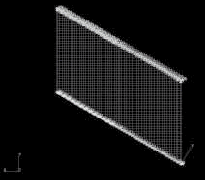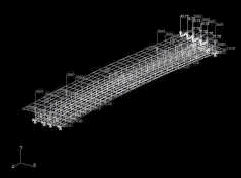U.S. Department of Transportation
Federal Highway Administration
1200 New Jersey Avenue, SE
Washington, DC 20590
202-366-4000
Focus
| Accelerating Infrastructure Innovations |
Publication Number: FHWA-RD-02-011
Date: June 2002
In today's world of high-end computers, the finite element method has emerged as a powerful analysis tool for structural applications. The method involves simulating the structure's behavior by building a computer model and breaking down the structure into an assembly of finite-sized elements. The behavior of the elements and the overall structure can then be obtained by formulating a system of constitutive relationship and algebraic equations that can be readily solved with computer processors. "The power of the finite element analysis method lies in its versatility. Its applications are unlimited," says Waider Wong of the Federal Highway Administration's (FHWA) Eastern Resource Center (ERC).
The structural-related applications of the finite element analysis (FEA) method include:
To define a good FEA model and generate useful results, experience, good engineering judgment, and understanding of FEA computer software capabilities are vital. The structural team at the ERC has specialized training in the field of finite element modeling and now offers FEA as a new service to its FHWA division offices and State highway agencies.
The ERC's structural team recently evaluated a series of bridge ramp structures in Washington, DC, that had been built in the early 1970s. Annual inspections had shown that numerous locations inside the box cells had visual defects and discontinuities. Because of the complex arrangement of the structural components inside the multi-cell box girder, conventional bridge analysis software was not able to capture the effects of localized stress distribution. This analysis is important in determining the leading cause of deficiencies that have been visually detected and revealing problem areas that have not been discovered. The ERC team created a finite element model of all of the components, using a program known as MSC/NASTRAN. The analysis indicated that the bridge could experience marginal stresses in certain components but not to the point that immediate fractures or failures were anticipated. The stress zones were highlighted in a full report, which recommended that the scope of repair could be limited to these zones without compromising the functional safety of the structure.
The ERC team was also called upon to assist with stress analysis of fiber reinforced polymer (FRP) composite sandwich panels used on a deck replacement project in Pennsylvania. The use of FRP composites, which consist of glass fibers with thermoset resins, has been gaining acceptance and popularity in the bridge construction industry due to the composites' high strength, stiffness-to-weight ratio, and corrosion resistance. Because of the complex behavior of the material properties, FEA is often used to handle the stress analysis for FRP structures. Although in this case the bridge manufacturer had produced an FEA report on the deck, upon reviewing the report it was discovered that the longitudinal epoxy joint used to connect two of the deck panels was missing from the original FEA model. While failure of this joint would not cause immediate concern with respect to the bridge's operational safety, its function does impact live load distribution and deflection control on the bridge deck. The ERC team was asked to create another full FEA model that included this joint to study the joint's structural integrity and performance.
 |
 |
| Finite element models, such as the ones shown above, can simulate a structure's behavior. | |
The team's concluding analysis indicated that the effectiveness of this joint system significantly impacts the structure's load transfer mechanism, which influences the deck panels' response to different loading conditions. In a deck without any joint bonding, shear stresses come close to reaching the design shear strength of the composite material and total displacement is more than twice the desirable deflection limit. In the case of the Pennsylvania bridge, stresses exceeded the design strength but did not reach the failure strength of the joint. The ERC team recommended that the State continue to monitor the joint performance and look for any joint defects during future inspections.
The first nationwide FEA Applications in Infrastructure workshop is currently being planned. For more information on the workshop, the ERC's FEA services, or FEA in general, contact Waider Wong at the ERC, 410-962-9252 (fax: 410-962-4586; email: waider.wong@fhwa.dot.gov).